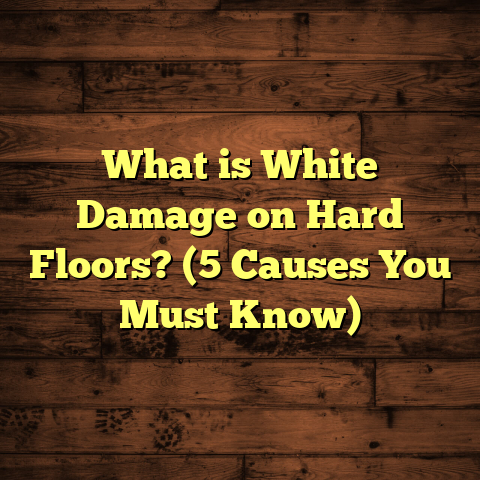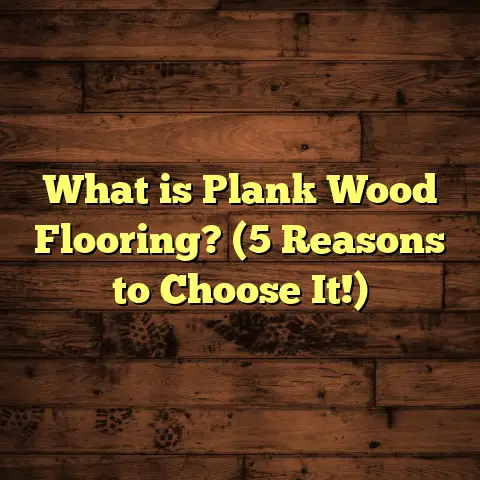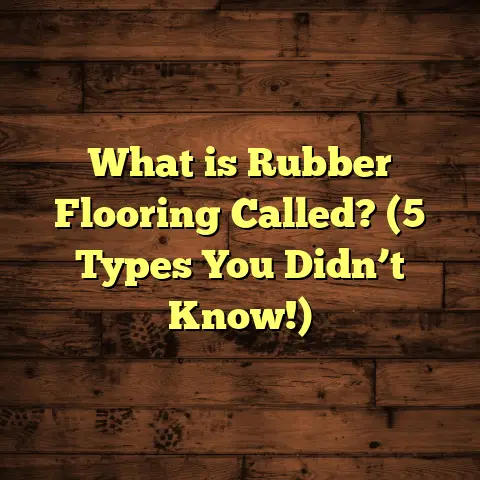What is Brick Flooring? (5 Benefits You Didn’t Expect)
I still remember the first time I stepped onto a brick floor indoors. It was at a friend’s house—an old farmhouse they had renovated. The moment I walked into the kitchen, I was struck by how different it felt underfoot compared to the usual hardwood or tile floors I was used to. There was an earthy warmth, a rough-but-welcoming texture that somehow made the whole room feel cozy and grounded. It was a bit of a surprise to me because, until then, I had always thought bricks belonged outside—on patios or garden paths—but not inside the home. That experience got me curious. Over the years, as I started installing brick flooring myself and researching its properties, I realized there’s so much more to it than just looks.
If you’ve ever wondered what brick flooring really is and why it might be worth considering for your space, I’m here to share everything I’ve learned — including some benefits you probably didn’t expect.
What Is Brick Flooring?
Let’s start simple: brick flooring is a type of floor covering made from bricks. But these aren’t just any bricks you find lying around. The bricks used for flooring are specially made to be strong, durable, and suitable for walking on.
Most commonly, brick flooring is made from clay bricks that have been kiln-fired at high temperatures. This process gives them their hardness and durability. The bricks are then laid down on a stable base—usually a concrete slab or a compacted sand bed—in various patterns. Once laid, the gaps between the bricks are filled with mortar or grout to create a solid surface.
Now, you might be imagining rough, uneven surfaces like old brick walls or chimneys. That’s understandable, but brick floors are prepared differently. The bricks are often sanded or polished to create a smoother surface that’s comfortable to walk on. Some even have a glazed finish to add protection against stains and moisture.
Different Types of Brick Flooring
There’s actually some variety when it comes to brick floors:
- Traditional Clay Brick Floors: These are classic red or brown clay bricks fired in a kiln. They offer that authentic rustic look.
- Pressed Brick Pavers: These are machine-pressed for uniformity and strength and often have smoother finishes.
- Glazed Bricks: Bricks coated with a ceramic glaze for added color options and stain resistance.
- Reclaimed Brick Flooring: Old bricks salvaged from demolition sites are cleaned and reused for flooring, giving an eco-friendly, vintage vibe.
Each type offers different textures, colors, and durability levels depending on your needs and style preferences.
Installation Methods
Installing brick flooring isn’t as simple as just laying bricks side by side. It requires careful preparation:
- Base Preparation: A strong, level base is essential. Most installers use poured concrete or compacted sand as the foundation.
- Laying Patterns: Bricks can be arranged in many patterns like running bond (staggered rows), herringbone (zigzag), basketweave, or stack bond (aligned rows). The pattern affects both aesthetics and stability.
- Mortar or Grout Filling: After laying bricks, mortar fills the joints to lock them in place and prevent shifting.
- Sealing: Because bricks are naturally porous, sealing them protects against stains, water damage, and wear.
I’ve installed brick floors using both mortar joints and dry-laid sand joints. Mortar joints create a firmer surface but require more precision. Sand joints allow for some flexibility and better drainage in outdoor or semi-outdoor spaces.
Benefit 1: Durability That Surprises Even Experienced Contractors
When I first started my flooring career, I assumed bricks would chip easily indoors—after all, they’re hard but brittle materials when used vertically in walls. But after years of installing and maintaining brick floors, I can confidently say their durability surprised me.
Bricks are incredibly strong under compression, which means they can handle heavy foot traffic without cracking. The firing process during manufacturing gives them hardness ratings ranging from 7,000 to 15,000 psi (pounds per square inch). To compare, hardwood floors have a Janka hardness rating around 1,200–2,000, depending on species. So bricks can withstand substantial loads and impacts.
One memorable project was a commercial kitchen floor made entirely of brick tiles. The owner was skeptical about bricks being suitable for such a high-traffic environment with frequent spills and dropped utensils. After five years of daily use, the floor showed minimal wear—mostly minor scuffs that added character rather than damage.
Durability also means fewer repairs and replacements over time. While hardwood can scratch or dent and vinyl can peel or tear, brick floors tend to last decades or even centuries if installed properly.
Data on Longevity
A survey of historic buildings with original brick floors shows many still intact after over 100 years of use. This longevity is unmatched by most modern flooring materials.
Brick floors also resist fire better than wood or vinyl since clay bricks are non-combustible.
Benefit 2: Natural Thermal Mass Contributes to Energy Savings
One of the perks I didn’t expect when working with brick floors was their natural ability to regulate temperature indoors. This happens because bricks have high thermal mass—they absorb heat slowly and release it gradually.
If you live in a climate with distinct seasons, this can help balance indoor temperatures:
- In summer, brick floors absorb excess heat during the day, keeping rooms cooler.
- At night or during colder months, they release stored warmth back into the air.
This natural “thermal buffering” means your heating and cooling systems don’t have to work as hard to maintain comfort.
Research-Backed Benefits
The U.S. Department of Energy highlights thermal mass materials like brick as effective energy savers in building design. Their studies show that thermal mass can reduce annual heating and cooling energy use by up to 15% in some climates.
In one project I worked on in the Midwest, homeowners reported lower utility bills after switching from vinyl to brick flooring in their living areas—especially during winter months when radiant heat systems complemented the flooring’s heat retention.
Benefit 3: Low Maintenance With Everlasting Style
If you’re like most people I talk to about flooring options, maintenance is a big factor. Nobody wants a floor that demands constant polishing or specialized cleaning products.
Brick floors are surprisingly low-maintenance compared to hardwood or carpet. Here’s what I usually recommend:
- Regular sweeping or vacuuming to remove dirt and grit (which can scratch finishes).
- Occasional mopping with mild soap and water.
- Sealing every few years to protect against stains and moisture penetration.
Sealing is crucial because bricks are naturally porous—they can absorb spills if left untreated. But once sealed properly with penetrating sealers or topical finishes, they resist staining well.
One café owner I worked with chose brick floors partly because they wanted something durable but easy to clean after food spills. Two years later, the floor looked great with just routine cleaning—no refinishing needed.
Benefit 4: Environmentally Friendly Flooring Option
Sustainability has become a major concern for many homeowners I help these days. If you want flooring that’s eco-friendly without sacrificing style or durability, brick should be on your radar.
Bricks are made from natural clay earth materials found all over the world. Unlike synthetic materials like vinyl or laminate (which rely heavily on plastics and chemicals), bricks have minimal processing requirements beyond shaping and firing.
Why Brick Flooring is Green
- Natural raw materials: Clay and shale are abundant and non-toxic.
- Low embodied energy: Manufacturing bricks requires less energy than producing vinyl or engineered wood products.
- Long lifespan: Long-lasting floors mean fewer replacements and less waste.
- Recyclability: Old bricks can be reclaimed from demolition projects and reused as flooring or landscaping material.
A 2023 Environmental Product Declaration survey showed clay bricks had one of the lowest carbon footprints among common flooring materials—making them ideal for sustainable building projects.
Benefit 5: Unique Aesthetic That Adds Warmth & Character
Finally, let’s talk about style—because brick floors definitely make a statement.
Unlike uniform tiles or planks, every brick has subtle variations in color, texture, and shape due to natural clay composition and firing conditions. This creates a floor surface full of life and character that changes with light throughout the day.
I love how clients often tell me their brick floors become conversation pieces whenever guests come by—the floor feels like a piece of history beneath your feet.
Patterns & Design Flexibility
You can customize brick flooring by choosing different laying patterns:
- Running Bond: Classic staggered rows
- Herringbone: Zigzag for more visual interest
- Basketweave: Alternating pairs for texture
- Stack Bond: Aligned rows for modern simplicity
Different finishes also change the look—from rustic matte surfaces to glossy glazed bricks resembling ceramic tiles.
In one recent project, a homeowner went for reclaimed bricks arranged in herringbone pattern with light grout lines—a perfect blend of vintage charm and modern style that tied their kitchen design together beautifully.
Personal Stories & Tips From My Experience
Over my career installing brick floors in homes across various regions, I’ve picked up some insights that might help you if you’re thinking about this material:
- Prep is everything: A solid base prevents cracking later on.
- Hire experienced installers: Brick laying requires skill to get patterns straight and joints tight.
- Expect some natural variation: Don’t worry if colors differ slightly; it adds charm.
- Use quality sealers: This protects your investment over time.
- Pair with radiant heat: Brick floors work wonderfully with underfloor heating systems for extra comfort.
Cost Considerations
You might wonder about price compared to other flooring options. Brick flooring generally falls into mid-range costs:
- Material prices vary between $5–$15 per square foot depending on type
- Installation labor costs range from $8–$20 per square foot due to skilled work involved
- Sealing adds about $1–$2 per square foot initially plus maintenance every few years
While not cheapest upfront, bricks’ longevity and low maintenance often make them more cost-effective over decades compared to materials needing frequent replacement.
To plan your budget accurately, I recommend using tools like FloorTally—they provide local material & labor cost estimates personalized for your project area and preferences.
Common Questions About Brick Flooring
Q: Is brick comfortable to walk on barefoot?
A: Yes! When properly installed and sealed smooth, brick floors feel warm and textured but not rough or uncomfortable underfoot.
Q: Can brick floors be installed over radiant heating?
A: Absolutely. Brick’s thermal mass actually enhances heat retention making rooms cozy while saving energy.
Q: Are brick floors slip-resistant?
A: Yes—bricks typically have enough texture for good traction. Sealed finishes can be chosen to enhance slip resistance further if needed.
Q: How do brick floors hold up in wet areas like bathrooms?
A: Sealed bricks resist moisture well but grout lines need care to prevent mold buildup. Proper sealing & ventilation help maintain durability in wet zones.
I hope this gives you a clear picture of what brick flooring is all about beyond just its rustic look. From unexpected durability and energy savings to eco-friendly benefits and timeless style—it’s a flooring choice that’s earned its place through centuries for good reasons.
If you’re considering brick floors for your home or business, don’t hesitate to reach out for advice on installation methods or maintenance tips based on real-world experience—I’m here to help!
Ready to explore budget options? Tools like FloorTally will give you tailored estimates so you can plan smartly before making decisions.
Have more questions? Just ask—I love talking about this fascinating material!





